So, you’ve done the wise thing and decided to diversify; in translating your website into a language other than English, you won’t just be enhancing your global reach – you’ll be doing so with millions more potential clients in less competitive online marketplaces.
Since the publication of our recent article comparing some common WordPress translation plugins, we’ve received requests for a tutorial on the basic functions of the biggest and best one out there: WPML.
One oddly common misconception is that by buying your WPML package, you won’t need a translation team. WPML is indeed a “translation tool”; but it is not a translation tool in the same sense that Google translate is. While the latter will automatically generate a (dubious) foreign language equivalent, WPML is fundamentally a Human Translation Platform. What it crucially does it facilitates the translation process into multiple languages under a single WordPress domain.
On the assumption that you’ve already bought and installed your WPML package, we can begin our basic guide to getting the most out of it.
1) Log in to the backend of your WordPress site.
2) Hover over the ‘Plugins’ option on the toolbar to the left of the screen. Activate the WPML Multilingual CMS Plugin; this is the core plugin, required for every WPML translation project. Download and activate other plugins from the WPML suite like WPML String Translation to translate texts that are outside of posts & pages; the result should look something like this.

3) Specify the current content language as the default during the activation set-up screens.
4) Select the languages to be enabled on your site; you can alter these selections at a later date, so mistakes don’t matter here.

6) Add a language switcher; this is how the visitors to your front end will navigate between your translated sub-domains on the actual website. You will then be given options to add a language switcher style, such as a drop down menu, native language name, and a list of flags. You can choose a combination of these if you please. This feature should work with all default themes.


7) On the question of themes – if you are planning to translate to a language like Arabic or Hebrew, make sure you are working with a theme that can support Right-to-Left scripts. (and vice-versa, if you are translating from such a language into a Left-to-Right script language like English or French). Doing this will ensure you avoid a whole host of formatting and layout nightmares that really don’t bear thinking about too much.
8) You can toggle your Admin Language; for example, if you are working with a team of Spanish translators, you can make their lives easier by temporarily setting Spanish as the Admin language.

9) If you are developing a translated website for a new market, you can temporarily hide one language section from the general public, while still being able to view it yourself, allowing you to tinker.

10) When you want to create a translation unit for any page of your content, go to your posts on the back-end. There will be a + sign under each post in a column for each of your additional languages. Click on plus, and it will create the new page. This method is manual translation.

11) There will now be a page with the same interface, but with modified settings for the target language of the translation; import the pre-prepared translation of the article in the target language both in the title and content sections, then click publish.
12) For the translation itself, you have two options. Firstly, you can create the content from scratch in the new post page. Alternatively, you can click the button labelled “Copy Content from English” and rework it from there; this copy function only works for the main body of content.

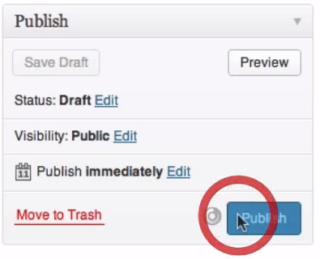
13) The second option is Duplicate: This allows you to link a translated language directly with the default language.

Doing this will create an exact copy of the specified page in the target language.
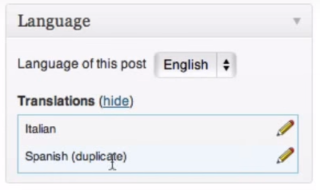
Now, whenever you add text in the default language version, this will be reproduced in the duplicate page (which will have the front-end interface in the target language), at which point you may proceed with the translation; to do this, you will see the following option in the top-right hand corner.
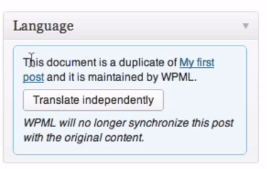
14) The Translation Management Module is the plugin that can streamline your liaison with your chosen Language Service Provider, leaving you to focus on the quality of your source content.
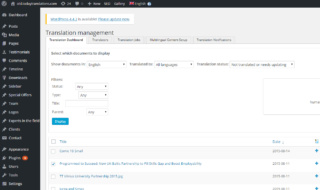
There will be a check-box next to each page title. When you check one, you can individually select which translator is assigned which job at the bottom of the page, as shown in the following snapshot.

15) WPML’s XLIFF interface is what you will need to use for sending your site’s content to external translators. Since the WPML Version 3.2, this module has been incorporated into the Translation management Module. XLIFF is the standardized file type for all kinds of localizable data, and an XLIFF file will include all the content to be translated – which you can then send as an email attachment from the Translation Dashboard to your selected translation team, once they have linked their WordPress account with yours. You can then easily upload the finished translations once your translation team has sent them back.
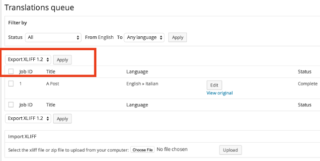
16) The export and import of your XLIFFs is simple, but very important. When they click on apply in the above screen in the Translation Management module, the XLIFF download should start immediately.
17) Once your translators have completed the translations of their assigned pages, they should be able to import their XLIFF files by going to the ‘translations’ subheader in WPML and using the simple upload function at the bottom of the page.

This was just a brief run-through of the set up and the most basic functions of WPML. The full scope of its capabilities is much broader, and as ever, practice will make perfect. Nonetheless, expert help is at hand. One of the key advantages WPML has over its competitors is the dependability of their customer service. Its forums are thronging with active users, and phone support is just a call away.
Today Translations is an award-winning language service agency based in the City of London. Website translation is one of our great strengths. If you are looking to get your WordPress translated with a consultative, all-inclusive process, get in touch with our team today.
Check out the rest of the Today Translations News and Resources Section

